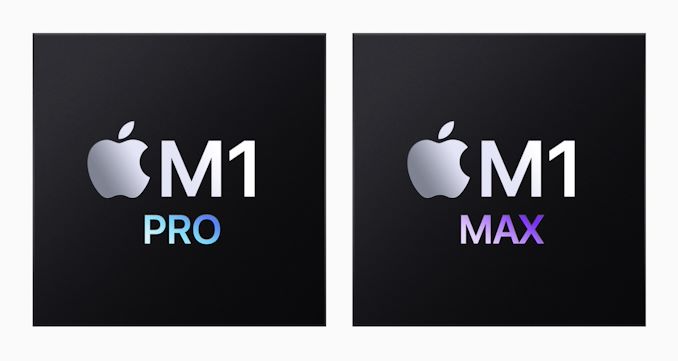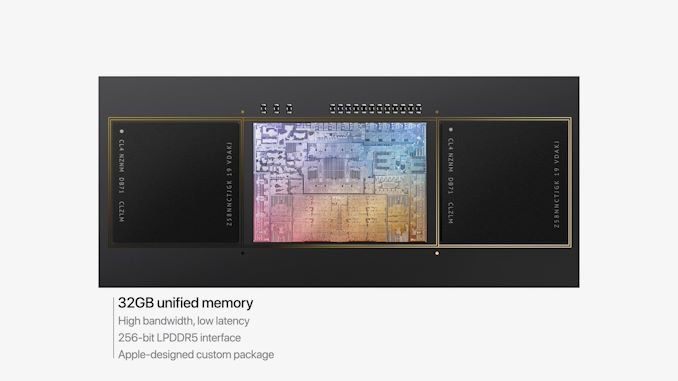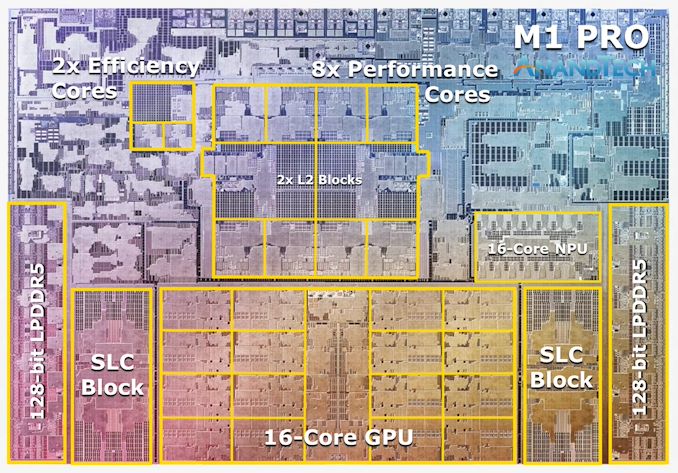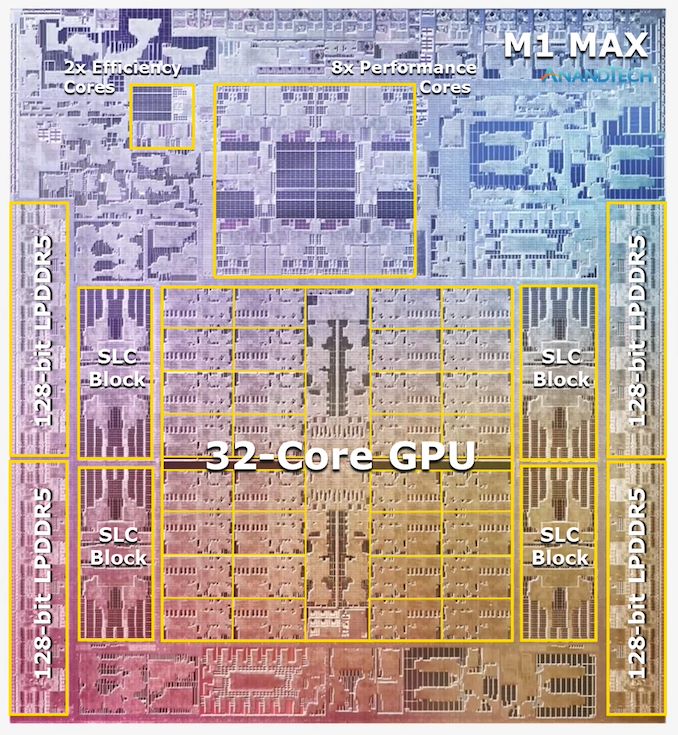Apple's M1 Pro, M1 Max SoCs Investigated: New Performance and Efficiency Heights
by Andrei Frumusanu on October 25, 2021 9:00 AM EST- Posted in
- Laptops
- Apple
- MacBook
- Apple M1 Pro
- Apple M1 Max

Last week, Apple had unveiled their new generation MacBook Pro laptop series, a new range of flagship devices that bring with them significant updates to the company’s professional and power-user oriented user-base. The new devices particularly differentiate themselves in that they’re now powered by two new additional entries in Apple’s own silicon line-up, the M1 Pro and the M1 Max. We’ve covered the initial reveal in last week’s overview article of the two new chips, and today we’re getting the first glimpses of the performance we’re expected to see off the new silicon.
The M1 Pro: 10-core CPU, 16-core GPU, 33.7bn Transistors
Starting off with the M1 Pro, the smaller sibling of the two, the design appears to be a new implementation of the first generation M1 chip, but this time designed from the ground up to scale up larger and to more performance. The M1 Pro in our view is the more interesting of the two designs, as it offers mostly everything that power users will deem generationally important in terms of upgrades.
At the heart of the SoC we find a new 10-core CPU setup, in a 8+2 configuration, with there being 8 performance Firestorm cores and 2 efficiency Icestorm cores. We had indicated in our initial coverage that it appears that Apple’s new M1 Pro and Max chips is using a similar, if not the same generation CPU IP as on the M1, rather than updating things to the newer generation cores that are being used in the A15. We seemingly can confirm this, as we’re seeing no apparent changes in the cores compared to what we’ve discovered on the M1 chips.
The CPU cores clock up to 3228MHz peak, however vary in frequency depending on how many cores are active within a cluster, clocking down to 3132 at 2, and 3036 MHz at 3 and 4 cores active. I say “per cluster”, because the 8 performance cores in the M1 Pro and M1 Max are indeed consisting of two 4-core clusters, both with their own 12MB L2 caches, and each being able to clock their CPUs independently from each other, so it’s actually possible to have four active cores in one cluster at 3036MHz and one active core in the other cluster running at 3.23GHz.
The two E-cores in the system clock at up to 2064MHz, and as opposed to the M1, there’s only two of them this time around, however, Apple still gives them their full 4MB of L2 cache, same as on the M1 and A-derivative chips.
One large feature of both chips is their much-increased memory bandwidth and interfaces – the M1 Pro features 256-bit LPDDR5 memory at 6400MT/s speeds, corresponding to 204GB/s bandwidth. This is significantly higher than the M1 at 68GB/s, and also generally higher than competitor laptop platforms which still rely on 128-bit interfaces.
We’ve been able to identify the “SLC”, or system level cache as we call it, to be falling in at 24MB for the M1 Pro, and 48MB on the M1 Max, a bit smaller than what we initially speculated, but makes sense given the SRAM die area – representing a 50% increase over the per-block SLC on the M1.
The M1 Max: A 32-Core GPU Monstrosity at 57bn Transistors
Above the M1 Pro we have Apple’s second new M1 chip, the M1 Max. The M1 Max is essentially identical to the M1 Pro in terms of architecture and in many of its functional blocks – but what sets the Max apart is that Apple has equipped it with much larger GPU and media encode/decode complexes. Overall, Apple has doubled the number of GPU cores and media blocks, giving the M1 Max virtually twice the GPU and media performance.
The GPU and memory interfaces of the chip are by far the most differentiated aspects of the chip, instead of a 16-core GPU, Apple doubles things up to a 32-core unit. On the M1 Max which we tested for today, the GPU is running at up to 1296MHz - quite fast for what we consider mobile IP, but still significantly slower than what we’ve seen from the conventional PC and console space where GPUs now can run up to around 2.5GHz.
Apple also doubles up on the memory interfaces, using a whopping 512-bit wide LPDDR5 memory subsystem – unheard of in an SoC and even rare amongst historical discrete GPU designs. This gives the chip a massive 408GB/s of bandwidth – how this bandwidth is accessible to the various IP blocks on the chip is one of the things we’ll be investigating today.
The memory controller caches are at 48MB in this chip, allowing for theoretically amplified memory bandwidth for various SoC blocks as well as reducing off-chip DRAM traffic, thus also reducing power and energy usage of the chip.
Apple’s die shot of the M1 Max was a bit weird initially in that we weren’t sure if it actually represents physical reality – especially on the bottom part of the chip we had noted that there appears to be a doubled up NPU – something Apple doesn’t officially disclose. A doubled up media engine makes sense as that’s part of the features of the chip, however until we can get a third-party die shot to confirm that this is indeed how the chip looks like, we’ll refrain from speculating further in this regard.














493 Comments
View All Comments
UnNameless - Wednesday, November 17, 2021 - link
Where did you get the 3000 writes number from?I know for a fact that I did >1000 full drive writes on my 1TB SSD in my iMac Pro and it barely hit 86% SSD lifetime! So I wrote more than 1PB of data and still got 86% life in it!
coolfactor - Tuesday, October 26, 2021 - link
Hey folks, listen to turbine! He really knows what he's talking about! I mean, he's never used a Mac, or he'd know better, but hey, listen to him anyway! He can't get the OS names correct (it's macOS and iOS, with a small "i"), but hey, he's making an important point! So important! More market share obviously means better! Yah? So that $2.00 cheeseburger from McDonalds is abviously the best because it's low-cost and everywhere! Yah, that's what matters, after all!Daniel Egger - Wednesday, October 27, 2021 - link
Don't be ridiculous. The 16" MBP with the M1 Max costs less than what I have paid for my TiBook way back when and that's without inflation considered. Oh, and back then I was just a student, tired of his Compaq Armada 1750 aka "the brick".xeridea - Tuesday, October 26, 2021 - link
Developers optimize for PC, knowing that Mac has virtually no marketshare for gamers. There are decent APUs and midrange gaming laptops that aren't hot and heavy.Altirix - Monday, October 25, 2021 - link
actually could be unlikely, Apple are trying to kill of any open-source low-level graphics API in favour of their own API metal. look at the smaller devs who are going to be less likely to go out their way to rewrite their engines to support metal especially when they also need to buy the hardware to test it on. prior to that is if macos can run it cool, if it can well that's a shame. big devs follow the money so the rest will be up to apple handing out engineers or there's enough people gaming on macphotovirus - Monday, October 25, 2021 - link
Apple doesn't try to kill Vulkan, it's just they don't care. They've eaten OpenGL problems for years and they've had enough, thus no respect for open-source. What they want is a fast modern cross-platform framework, and that's Metal. It's tightly controlled, so it's easy to implement any new hardware feature into it.Since there's a quite a number of iPads and Macs with M1, I think publishers will invest into Metal optimisation.
bernstein - Monday, October 25, 2021 - link
Metal isn‘t cross-platform. ios & macos are the same os with a different „skin“ (ui/lifecycle model).techconc - Monday, October 25, 2021 - link
@bernstein... That's like saying Andorid and Linux aren't different platforms... you know because they share some common ground. From a developer perspective, iOS and MacOS are different platforms. Yes, there is much similarity, but there are also differences.tunsten2k - Monday, October 25, 2021 - link
No, it's like saying Android and ChromeOS aren't different platforms, and generally, that would be a reasonable statement. Regardless, "cross platform" doesn't mean "across 2 proprietary platforms, only one of which is non-mobile and makes up only 16% of the non-mobile market". Get a grip :)Hrunga_Zmuda - Monday, October 25, 2021 - link
No, they are not the same OS. They have the same base, but they are quite different in many ways. But Metal isn't one of those differences. Metal is powerful and any developer who wants to break into the Mac world will be going there in the future.